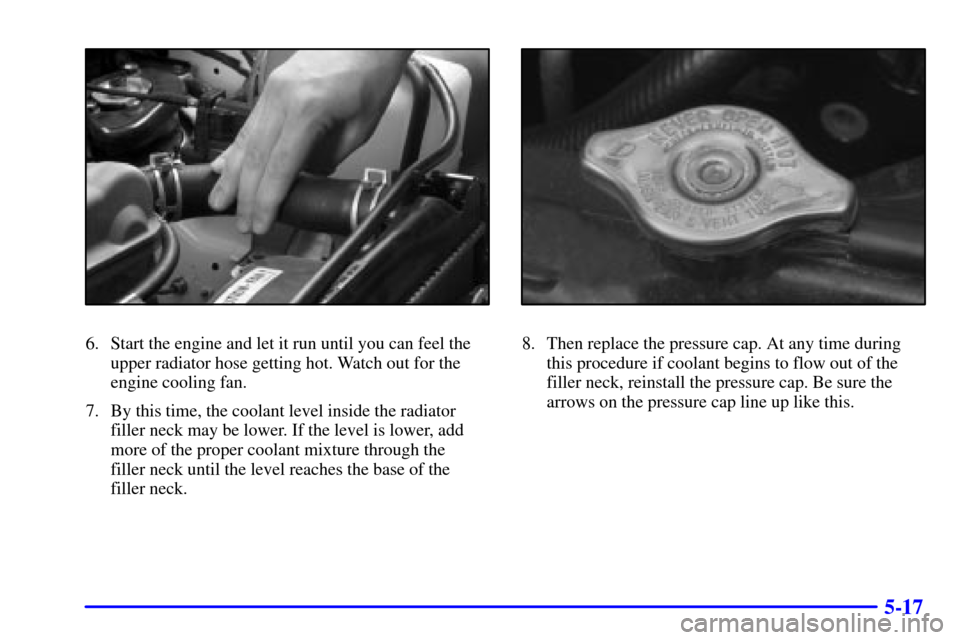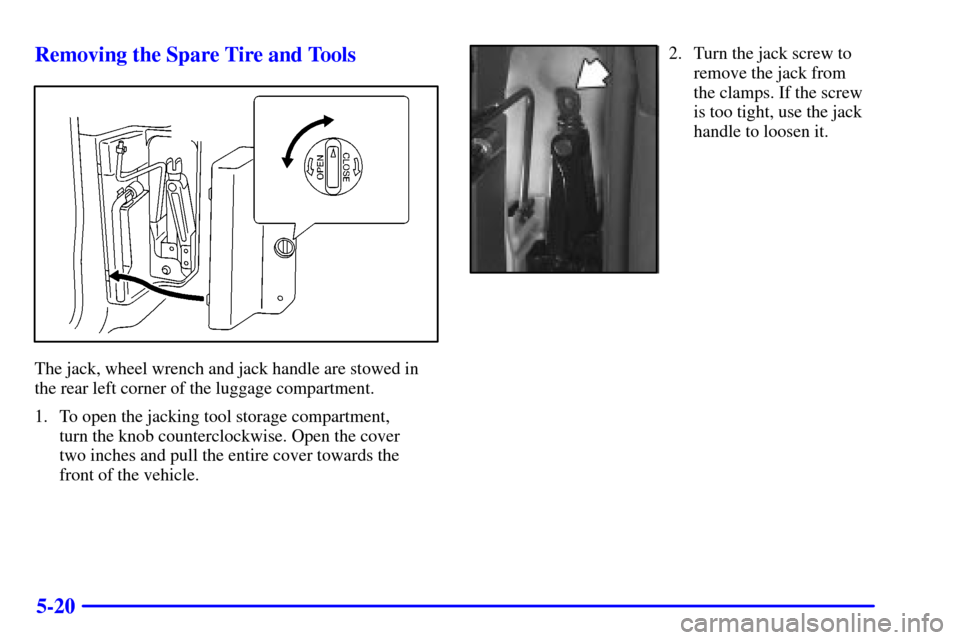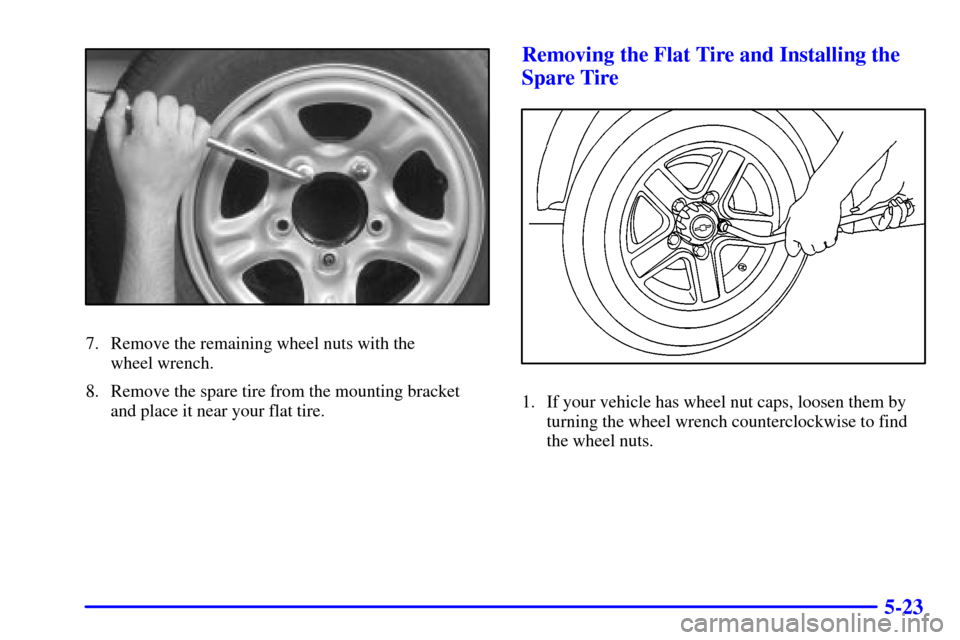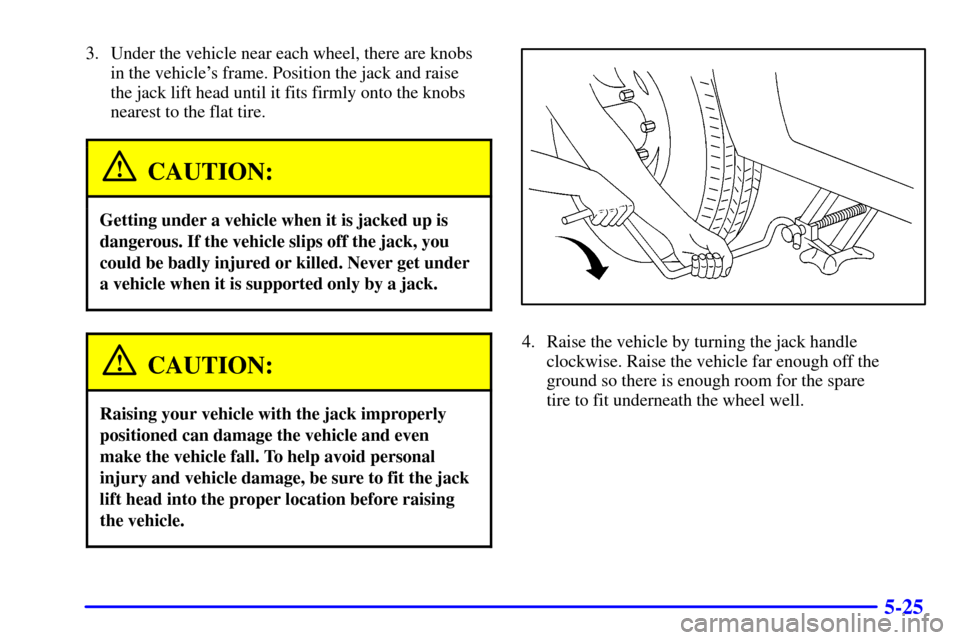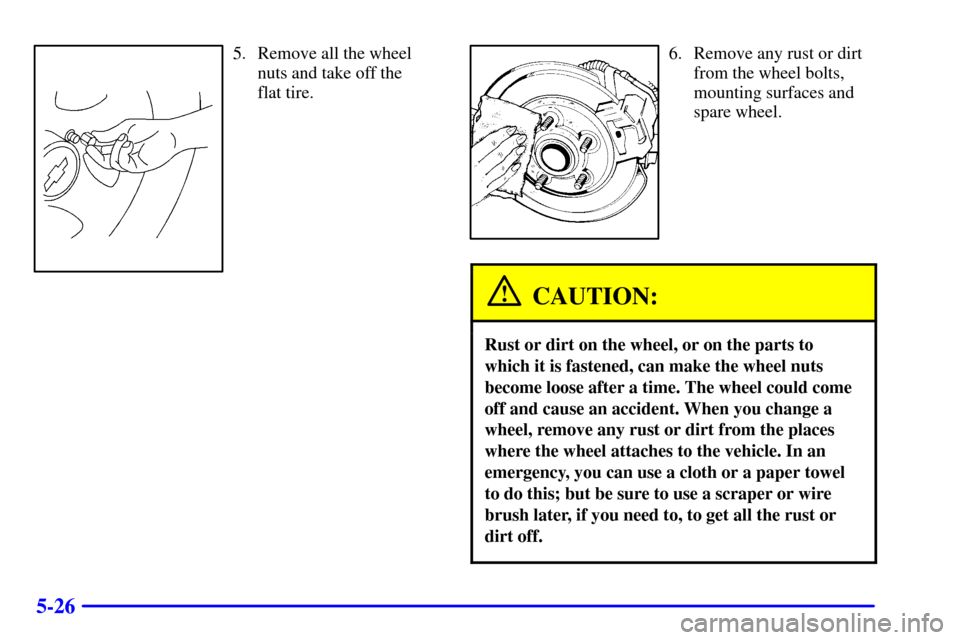CHEVROLET TRACKER 2002 2.G Owners Manual
TRACKER 2002 2.G
CHEVROLET
CHEVROLET
https://www.carmanualsonline.info/img/24/8345/w960_8345-0.png
CHEVROLET TRACKER 2002 2.G Owners Manual
Trending: weight, automatic transmission, tires, park assist, cooling, instrument cluster, warning
Page 231 of 390
5-17
6. Start the engine and let it run until you can feel the
upper radiator hose getting hot. Watch out for the
engine cooling fan.
7. By this time, the coolant level inside the radiator
filler neck may be lower. If the level is lower, add
more of the proper coolant mixture through the
filler neck until the level reaches the base of the
filler neck.8. Then replace the pressure cap. At any time during
this procedure if coolant begins to flow out of the
filler neck, reinstall the pressure cap. Be sure the
arrows on the pressure cap line up like this.
Page 232 of 390
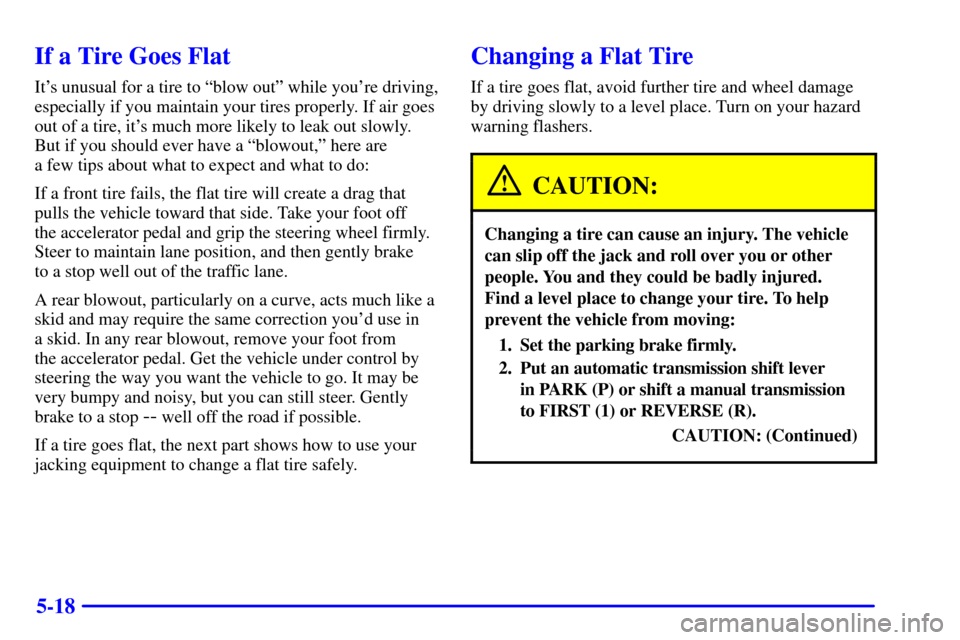
5-18
If a Tire Goes Flat
It's unusual for a tire to ªblow outº while you're driving,
especially if you maintain your tires properly. If air goes
out of a tire, it's much more likely to leak out slowly.
But if you should ever have a ªblowout,º here are
a few tips about what to expect and what to do:
If a front tire fails, the flat tire will create a drag that
pulls the vehicle toward that side. Take your foot off
the accelerator pedal and grip the steering wheel firmly.
Steer to maintain lane position, and then gently brake
to a stop well out of the traffic lane.
A rear blowout, particularly on a curve, acts much like a
skid and may require the same correction you'd use in
a skid. In any rear blowout, remove your foot from
the accelerator pedal. Get the vehicle under control by
steering the way you want the vehicle to go. It may be
very bumpy and noisy, but you can still steer. Gently
brake to a stop
-- well off the road if possible.
If a tire goes flat, the next part shows how to use your
jacking equipment to change a flat tire safely.
Changing a Flat Tire
If a tire goes flat, avoid further tire and wheel damage
by driving slowly to a level place. Turn on your hazard
warning flashers.
CAUTION:
Changing a tire can cause an injury. The vehicle
can slip off the jack and roll over you or other
people. You and they could be badly injured.
Find a level place to change your tire. To help
prevent the vehicle from moving:
1. Set the parking brake firmly.
2. Put an automatic transmission shift lever
in PARK (P) or shift a manual transmission
to FIRST (1) or REVERSE (R).
CAUTION: (Continued)
Page 233 of 390
5-19
CAUTION: (Continued)
3. If you have a four-wheel-drive vehicle,
be sure the transfer case is in a drive
gear
-- not in NEUTRAL.
4. Turn off the engine.
To be even more certain the vehicle won't move,
you can put blocks at the front and rear of the
tire farthest away from the one being changed.
That would be the tire on the other side of the
vehicle, at the opposite end.
The following steps will tell you how to use the jack and
change a tire.
Page 234 of 390
5-20 Removing the Spare Tire and Tools
The jack, wheel wrench and jack handle are stowed in
the rear left corner of the luggage compartment.
1. To open the jacking tool storage compartment,
turn the knob counterclockwise. Open the cover
two inches and pull the entire cover towards the
front of the vehicle.
2. Turn the jack screw to
remove the jack from
the clamps. If the screw
is too tight, use the jack
handle to loosen it.
Page 235 of 390
5-21
The tools you'll be using include the jack (A), jack
handle (B) and wheel wrench (C).The spare tire is mounted on your tailgate. Your vehicle
may be equipped with either a soft, vinyl cover or a
hard cover.
3. To remove the hard
cover from the spare
tire, insert your key into
the wheel lock and pull
the wheel lock off.
Hard Cover
Page 236 of 390
5-22
4. Using the wheel wrench, remove the wheel cover
nut. Gently pry the spare tire cover off the wheel.
Vinyl Cover
5. If your vehicle is equipped with a vinyl cover, unzip
the cover to find the wheel lock. Insert the key into
the wheel lock and pull it off.
6. Using the wheel wrench, remove the wheel nut under
the lock.
Page 237 of 390
5-23
7. Remove the remaining wheel nuts with the
wheel wrench.
8. Remove the spare tire from the mounting bracket
and place it near your flat tire.
Removing the Flat Tire and Installing the
Spare Tire
1. If your vehicle has wheel nut caps, loosen them by
turning the wheel wrench counterclockwise to find
the wheel nuts.
Page 238 of 390
5-24
2. Using the wheel wrench, loosen all the wheel nuts
but don't remove them yet.
Front Wheel Location
Rear Wheel Location
Page 239 of 390
5-25
3. Under the vehicle near each wheel, there are knobs
in the vehicle's frame. Position the jack and raise
the jack lift head until it fits firmly onto the knobs
nearest to the flat tire.
CAUTION:
Getting under a vehicle when it is jacked up is
dangerous. If the vehicle slips off the jack, you
could be badly injured or killed. Never get under
a vehicle when it is supported only by a jack.
CAUTION:
Raising your vehicle with the jack improperly
positioned can damage the vehicle and even
make the vehicle fall. To help avoid personal
injury and vehicle damage, be sure to fit the jack
lift head into the proper location before raising
the vehicle.
4. Raise the vehicle by turning the jack handle
clockwise. Raise the vehicle far enough off the
ground so there is enough room for the spare
tire to fit underneath the wheel well.
Page 240 of 390
5-26
5. Remove all the wheel
nuts and take off the
flat tire.6. Remove any rust or dirt
from the wheel bolts,
mounting surfaces and
spare wheel.
CAUTION:
Rust or dirt on the wheel, or on the parts to
which it is fastened, can make the wheel nuts
become loose after a time. The wheel could come
off and cause an accident. When you change a
wheel, remove any rust or dirt from the places
where the wheel attaches to the vehicle. In an
emergency, you can use a cloth or a paper towel
to do this; but be sure to use a scraper or wire
brush later, if you need to, to get all the rust or
dirt off.
Trending: battery, sunroof, octane, transmission, steering, door lock, mirror controls
